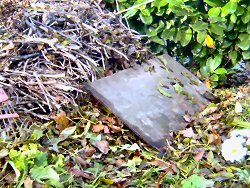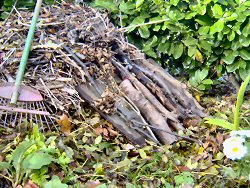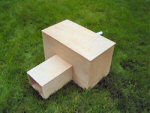| Features: Homes for garden animals |  |
Creating a home for hedgehogs
If you have hedgehogs (Erinaceous europeaus) in your garden you will almost certainly have seen them; although chiefly nocturnal, they will often be seen about the garden by daylight - especially in the evening.
 The hedgehog: a familiar and welcome garden visitor. (View bigger image.)
Hedgehogs are welcomed by most gardeners: they cause little or no harm and do a very good jog of keeping slug numbers down. For many of us, The hedgehog: a familiar and welcome garden visitor. (View bigger image.)
Hedgehogs are welcomed by most gardeners: they cause little or no harm and do a very good jog of keeping slug numbers down. For many of us,  they are special because they are generally the largest mammal that we regularly see in our gardens they are special because they are generally the largest mammal that we regularly see in our gardens they are special because they are generally the largest mammal that we regularly see in our gardens. (Relatively few people are lucky enough to be visited by badger, fox or deer.) You can encourage hedgehogs to make even more use of your garden by providing a place for them to nest and/or hibernate. they are special because they are generally the largest mammal that we regularly see in our gardens. (Relatively few people are lucky enough to be visited by badger, fox or deer.) You can encourage hedgehogs to make even more use of your garden by providing a place for them to nest and/or hibernate.
A lean-to shelter for hedgehogs
As with most homes for wildlife, there is no need to spend a lot of money if your budget is tight. Indeed  the simplest way of building a hedgehog shelter is to make a sort of lean-to the simplest way of building a hedgehog shelter is to make a sort of lean-to the simplest way of building a hedgehog shelter is to make a sort of lean-to by placing an old board against a wall, fence or other structure and covering it in leaves, compost, soil, or branches. The gap under the board will provide a relatively dry shelter which a hedgehog might find suitable for hibernation. You can rake some dry leaves into that gap or provide a little dry straw if you wish, but a hedgehog is also capable of bringing material in itself. the simplest way of building a hedgehog shelter is to make a sort of lean-to by placing an old board against a wall, fence or other structure and covering it in leaves, compost, soil, or branches. The gap under the board will provide a relatively dry shelter which a hedgehog might find suitable for hibernation. You can rake some dry leaves into that gap or provide a little dry straw if you wish, but a hedgehog is also capable of bringing material in itself.
Hedgehog lean-to This is a very economical way of making a shelter for hedgehogs which is ideal for hibernation.  | | An old piece of plywood (not much use for anything else) has been leant over a pile of dry leaves against a stick pile. |
|  | | The lean-to has been covered with logs and sticks to secure the board from the wind and to improve its appearance. |
|
A more ambitious shelter Hedgehog box purchased from the RSPB. Hedgehog box purchased from the RSPB.
If your budget is larger and/or you have reasonable DIY skills, you might consider buying or making a more ambitious shelter which can be used for
 Dimensions in centimetres of hedgehog box purchased from the RSPB.
hibernation in the autumn and winter or for nesting in the summer. The box pictured here was purchased from the RSPB, but you you might consider making one yourself if you can get hold of the materials. Dimensions in centimetres of hedgehog box purchased from the RSPB.
hibernation in the autumn and winter or for nesting in the summer. The box pictured here was purchased from the RSPB, but you you might consider making one yourself if you can get hold of the materials.
This box was constructed almost entirely from 1cm 7-ply plywood. If you are making your own, your box will survive the elements longer if you can afford external quality (marine) plywood. The sides were held together by fixing them to supporting battons (2.5x2cm softwood). Two runners of the same softwood were also used on the base of the box to prevent it from coming into direct contact with the ground. A 20cm long plastic tube (here 2.7cm in diameter) was used as a vent in the back of the box (simply pushed snugly into a hole of the same diameter). Of course you can modify the dimensions and materials somewhat to suit those you have available: hedgehogs are not that fussy!
 it is vital to ensure that the ventilation tube clears any material placed over the box and that it is angled slightly downwards to prevent moisture running into the box it is vital to ensure that the ventilation tube clears any material placed over the box and that it is angled slightly downwards to prevent moisture running into the box Note that in natural situations, hedgehog nesting and hibernation sites are generally reasonably well ventilated. Because this type of constructed box is 'unnaturally' well enclosed, we must pay special attention to ventilation. When positioning the box, it is vital to ensure that the ventilation tube clears any material placed over the box and that it is angled slightly downwards to prevent moisture running into the box. Note that in natural situations, hedgehog nesting and hibernation sites are generally reasonably well ventilated. Because this type of constructed box is 'unnaturally' well enclosed, we must pay special attention to ventilation. When positioning the box, it is vital to ensure that the ventilation tube clears any material placed over the box and that it is angled slightly downwards to prevent moisture running into the box.
Have patience! Worth the wait: be patient; give hedgehogs time to get used to the new shelter. (View bigger image.)
A good time to create a shelter like either of those shown above is around September time, just before hibernation begins or in early spring before breeding starts. But you shouldn't feel constrained to wait for the 'right time' to build a shelter: just do it when the opportunity arises. If you want to clean out an established shelter, do it around late August or September after hedgehogs have finished breeding, but before they have started hibernation. Worth the wait: be patient; give hedgehogs time to get used to the new shelter. (View bigger image.)
A good time to create a shelter like either of those shown above is around September time, just before hibernation begins or in early spring before breeding starts. But you shouldn't feel constrained to wait for the 'right time' to build a shelter: just do it when the opportunity arises. If you want to clean out an established shelter, do it around late August or September after hedgehogs have finished breeding, but before they have started hibernation.
Once your shelter is in place,  be patient and don't be too disappointed if hedgehogs don't use the box right away be patient and don't be too disappointed if hedgehogs don't use the box right away be patient and don't be too disappointed if hedgehogs don't use the box right away. Even if hedgehogs don't use your shelter at all, what is certain is that some garden animal or another will. Perhaps voles or wood mice might find shelter in your 'hedgehog' lean-to: it might not be what you expected but you will, nevertheless, have made a valuable contribution towards enriching the wildlife habitat that is your garden. be patient and don't be too disappointed if hedgehogs don't use the box right away. Even if hedgehogs don't use your shelter at all, what is certain is that some garden animal or another will. Perhaps voles or wood mice might find shelter in your 'hedgehog' lean-to: it might not be what you expected but you will, nevertheless, have made a valuable contribution towards enriching the wildlife habitat that is your garden. | First published August 2004. | |
Copyright Richard Burkmar 2004. Permission is hereby granted for anyone to use this article for non-commercial purposes which are of benefit to the natural environment as long the original author is credited. School pupils, students, teachers and educators are invited to use the article freely. Use for commercial purposes is prohibited unless permission is obtained from the copyright holder. |
Back to home page
Do you live in Merseyside? Interested in its wildlife? | |